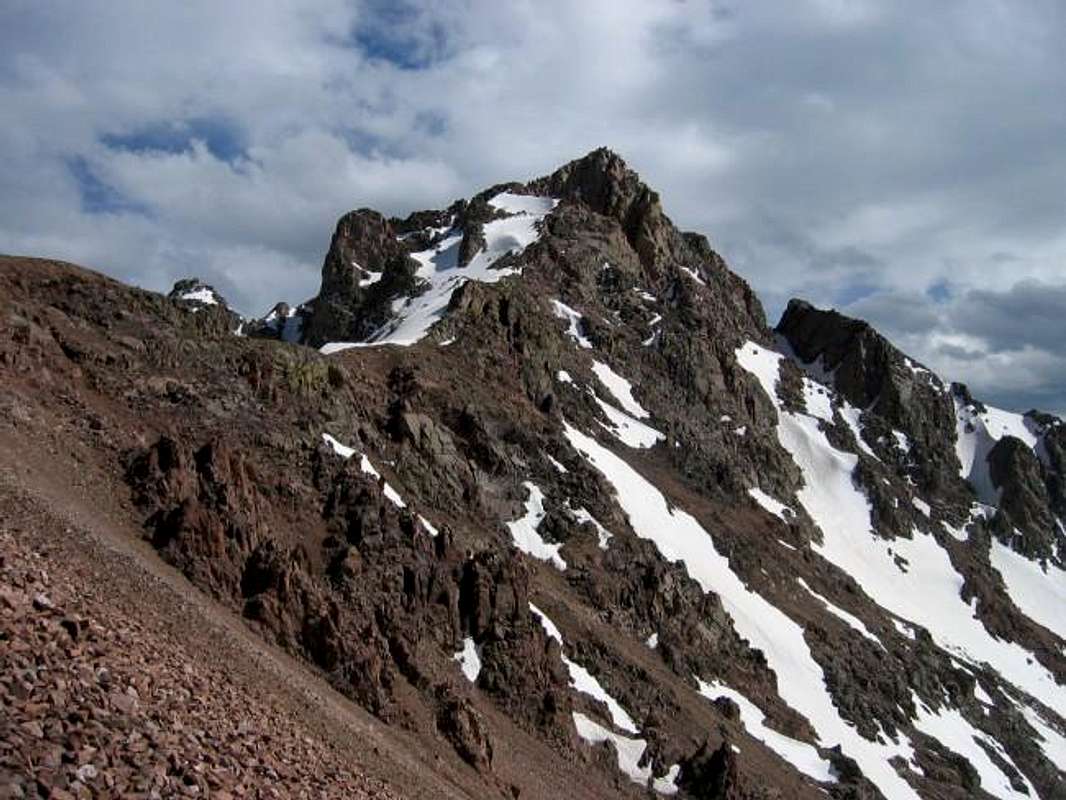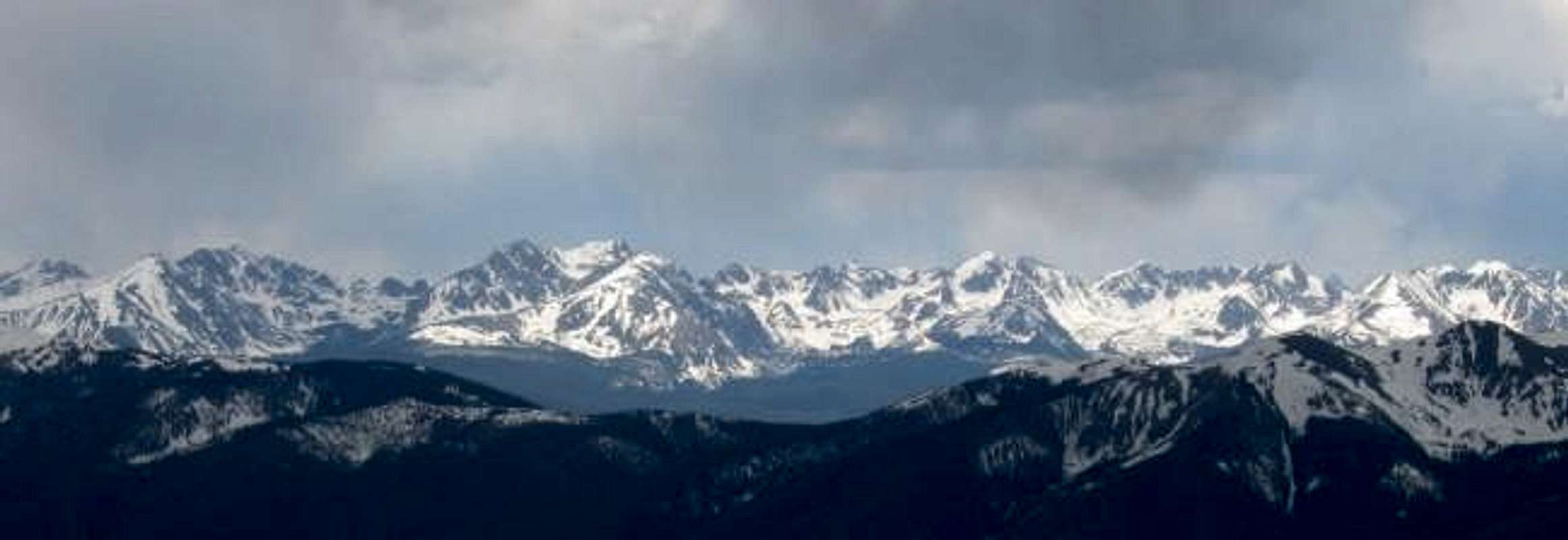-
 27677 Hits
27677 Hits
-
 86.36% Score
86.36% Score
-
 22 Votes
22 Votes
|
|
Mountain/Rock |
|---|---|
|
|
39.65100°N / 106.211°W |
|
|
13024 ft / 3970 m |
|
|
Gore Range Overview

Rugged and elegant Snow Peak glistening in the afternoon sunlight.
 Colorado’s spectacular but barely known Gore Range is host to many alpine summits over 13,000-ft and many more summits over 12,000-ft. In the relatively short stretch from Gore Pass in the north to Tenmile Creek in the south, the Gore range is densely populated with 50 some mountains over 12,000-ft. The Gores, rather then consisting of large isolated mountains rising from the timber or tundra, consist instead of dramatic serated ridges, with the summits being ridge junctions or highpoints. These dramatic ridges are riddled with gnarled, tooth-like spires that have mesmerized many world-class climbers. Many of these high and wild ridges actually have names like, The Zodiac Spires, Ripsaw Ridge, and The Grand Traverse.
Colorado’s spectacular but barely known Gore Range is host to many alpine summits over 13,000-ft and many more summits over 12,000-ft. In the relatively short stretch from Gore Pass in the north to Tenmile Creek in the south, the Gore range is densely populated with 50 some mountains over 12,000-ft. The Gores, rather then consisting of large isolated mountains rising from the timber or tundra, consist instead of dramatic serated ridges, with the summits being ridge junctions or highpoints. These dramatic ridges are riddled with gnarled, tooth-like spires that have mesmerized many world-class climbers. Many of these high and wild ridges actually have names like, The Zodiac Spires, Ripsaw Ridge, and The Grand Traverse. Geologicaly the Gore Range is a fault-block mountain range. Similiar to the Sangre de Cristos of Colorado and the Tetons of Wyoming in that these ranges are bounded by faults that broke and shifted, thrusting up the mountains while downdropping the valleys. Although the rock is similiar to the Idaho Springs Formation of the Front Range, the rugged Gore's contrasting orogensis makes thes mountains look quite different from the glaciated folded anticline that makes up the Front Range. Glaciers played an extensive role in carving the cirques and spires that abound in the Gores. Many of the drainages are choked by large terminal morraines at their lower reaches and cut by successive headwall higher up. Many headwalls are graced with gorgeous waterfalls.
Only 60 miles at its closest point from Denver, the Gore Range as a whole is relatively unknown and inaccessible. Due to the lack of mining roads that criss-cross more popular mountain ranges the interior of the Gore Range can be difficult to reach. Of the summits of the Gore Range none attain the magic 14,000-ft mark, which accounts for some of the ranges obscurity. The monarch of the Gore Range is the 13,534-ft. Mount Powell at the north end of the range. Overall, the west side of the Gore Range is more accessible than the east. If approaching from the east, expect long, tedious, bushwhacking adventures with difficult route finding.
A result of the Gore Range's obscurity is that few of the summits are officialy named. The Colorado Mountain Club and enterprising climbers have often bestowed their own names. These unofficial designations often are the "alphabet" designations of the early CMC trips (relics of the 1930's) or the more inspired names that came latter on (The Spider, Mount Solitude, etc). A list of these names and their elevations can be found at Gerry and Jennifer Roach's wonderful website. The process educating one's self about these mountains is quite rewarding. Hand label your maps.
Those of us that are determined to spend some time climbing the Gores should own updated U.S. Geological survey topography maps and brush up on their compass skills. Precise planning and execution are of paramount importance when selecting routes in this range. With solid route finding, many of these quiet summits can be climbed without a rope. Major faces and long jagged ridges provide unlimited technical climbing opportunities as well. An ice axe is highly recommended on any early season climbs.
Please do your own research and homework for the Gores because this mountain range lacks any current guidebook exposure. After developing strong map reading skills, go and discover for yourself the Gore Range magic you occasionally hear about.
Please see Theron Welch's excellent page on the Gore Range for more information. His photos and descriptions are inspiring and informative. Thank you Mr. Welch.
Text graciously provided by Kane with some elboration by myself.
Snow Peak Overview

Snow Peak, Mount Valhalla, and Hail Peak from Red Peak.
Snow Peak is an elegant sculpted peak found in the southern section of the Gore Range. This portion of the Gore Range, dominated by the massive Willow Peak, offers spectacular scenery; it is brimming with serrated ridges, waterfalls, and blankets of flowers in high alpine basins. The one noticable difference between the southern Gores and the northern Gores is that the talus is much more extensive in the south. The norther mountains have loose rock, but they are not so draped in skirts of talus as these southern summits. Snow Peak is a member of the "precipitation summits" also constituted by Rain Peak, Hail Peak and Sleet Peak. These mountains offer pleasures archtypal of the region.
Snow Peak is also distingushed by being a member of the mountains that rise above the glacial cirque containing Deluge Lake. This beautiful cirque is bounded, from northwest to southeast, by Grand Traverse Peak, Mount Valhalla, and Snow Peak. Together these mountains rise as glorious triumverate above the rolling tundra and emerald waters of Deluge Lake. They can be climbed together as a succulent combination. Snow Peak offers a perfect aesthetic balance to Grand Traverse Peak's easy exuberance and Mount Valhalla's guarded loft.
Snow Peak is distinguished from its two higher neighbors by its shapely and definate summit pyramid that rises at the junction of three gendarme ridden ridges. It is a handsome mountain with rugged features that belie the decently solid rock that comprises the ridge routes. Viewed from Deluge Lake, Snow Peak rises magnificently to the southeast. This posistion allows for a spectacle at sunset wherein Snow Peak takes on a ruset hue reminescent of the best the Sangres de Cristos have to offer.
The ascent of Snow Peak is a lesson in Colorado mountain aesthetics. The views from Snow Pass to the summit are memorable and pleasing. The standard route is a joy to ascend. The summit itself is small and dramatic. And the vertigo inspiring view from the summit is not to be missed.
Please click here for a large panorama of the Gores to the north, as seen from the summit of Snow Peak (Caution: This is a very large file). Across the Deluge Lake Basin is snowy Grand Traverse Peak. To the right of Grand Traverse Peak runs the Grand Traverse Ridge to North Traverse Peak. In the distance beyond the Grand Traverse Ridge is the high mass of Mount Powell. To the right of North Traverse Peak is Peak P with the large snowfield on its right slopes. To the right of P is hunched Peak X. Next is the high blocky summit of Peak Q with jagged Peak R to its right. To the right of R is Peak Z. Closer and in front of Z is Peak Y, and closer still Keller Mountain. Attached to Snow Peak by the ridge on the right, Mount Valhalla reigns the valley. Beyond are a host of other summits. If you can name more of the summits or correct errors in my description please comment on the page so I can add the information.
Getting There

The summit of Snow Peak trod upon by Colonelpyat and photographed by Kane.
Locating the Deluge Lake Trailhead is easy. From Denver, take I-70 west, past the Eisenhower Tunnel and on to the popular ski towns of Dillon and Silverthorne. Continue past Copper Mountain Ski Resort and on to Vail Pass. From Vail Pass, descend down to the city of Vail, Colorado and take exit 180, your first Vail exit on the right. Turn left and go under I-70 and take an immediate left (southeast) onto a feeder road. Take this road past numerous condominiums 2.10 mile southeast where it will bend to the north and go back under I-70. From here it is only .19 mile to the Deluge Lake Trailhead; there is plenty of parking. This is also the Gore Creek Trailhead, another great trail that provides access to many scintillating hikes and climbs.
Text graciously provided by Kane
Mountain Conditions
Expect snow up in the Deluge Basin until early June.
Click image to enlarge
Click here to view a 7-day forecast for Deluge Lake Basin at 11,400-ft
Text graciously provided by Kane
Red Tape
“Red Tape” per attm
No permits or fees are required. Like all wilderness areas no mechanized or motorized vehicles are permitted within the Eagles Nest boundaries.
Wilderness is land set aside as part of wild America, where man can be a visitor. The natural environment has not been disturbed. Travel is restricted to foot or horseback. No mechanized equipment is allowed.
For more information, contact the U.S. Forest Service at the # below:
Additional Resources:
Eastern Portion of the Wilderness:
Dillon Ranger District
680 River Parkway
Silverthorne, CO 80498
970-468-5400
or
Western Portion of the Wilderness:
Holy Cross Ranger District
P.O. Box 190, 24747 US HWY 24
Minturn, CO, 81645, Phone: 970-827-5715

The Southern Gore Range as seen from the east. The summits are, from left to right: Red Peak, Zodiac Spires, East Thorn, Willow Peak, Rain Peak, Hail Peak, Snow Peak, Mount Valhalla, Grand Traverse Peak, The Grand Traverse, North Traverse Peak, and Keller Mountain.













